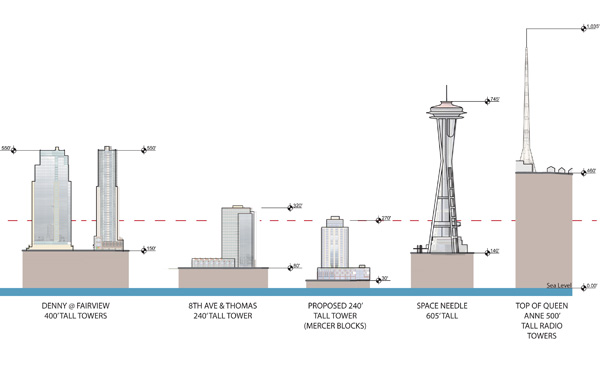South Lake Union vs. the Space Needle
In the debate over the proposed rezone in Seattle’s South Lake Union (SLU) neighborhood, one concern that’s raised repeatedly is views, of the Space Needle in particular. Because evaluating the view impacts of buildings is a complex three-dimensional problem, misinterpretations are common, and SLU is no exception.
One of the key factors in SLU is topography, as illustrated in the cross-sectional drawing below (click image for enlarged pdf):
SLU is in an oblong bowl that slopes down to the lake. This topography greatly reduces the impact new buildings in SLU would have on territorial views from surrounding neighborhoods such as Queen Anne or Capitol Hill. Note in particular the 240′ towers on the Mercer blocks, and their low elevation relative to the Space Needle. Some critics argue that building height should step down toward the lake, but nature has already provided that feature.
By far the most significant view impacts of development in SLU will be to pedestrians on the streets in the neighborhood. But tower height has very little effect on these impacts, because it is the first several floors of the building that matters most to views on the street. If tower heights are held low, you can be sure that the building bases will end up bulkier to make up for it, and street-level views (and sunlight) will suffer.
It may seem counterintuitive, but if it’s views from the public realm that we care about most, then we should allow tall buildings. Vancouver, B.C. is a living example. Include rules on tower spacing and maximum floorplate—as is the case with the proposed SLU rezone—and you’re good to go.
>>>
Disclosure:Â The diagram shown above was produced by VIA Architecture under contract with South Lake Union property owners. The author is an employee of VIA Architecture.


